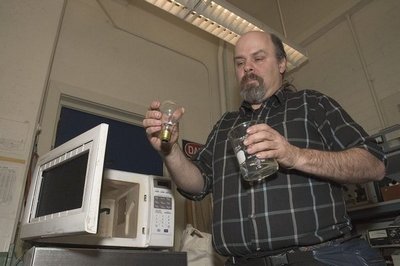January 19, 2006
UW’s original mad scientist does funny things with microwave ovens
Bill Beaty isn’t really a mad scientist — he just plays one on the Internet.
Slightly disheveled, balding, with a pony tail and a racing, multitrack mind, Beaty gives off an air of mischief. Iconoclastic, skeptical and eccentric, he’s a bit like an overgrown prodigy — the type who probably knows how to blow up the lab, but just chooses not to, on any given day.
He blows up other stuff, though, mostly inside microwave ovens. In fact, Beaty has been written up in several publications because of his penchant for what he humorously terms “Unwise Microwave Experiments” — in his spare time, and all for the cause of education.
At the UW, Beaty is a research engineer in the Department of Chemistry. He works in a cluttered lab area in the basement of Bagley Hall, littered with electronics and half-assembled research equipment. “We repair what scientists break,” he says of this work. “We keep expensive things from the 1970s going.”
But that’s just his day gig. On the Internet, Beaty has a growing reputation as a sort of Cyber Science Guru, which he feeds with lively writing about various science topics on several Web sites. The sites he maintains are www.scienceclub.org, which he says is for grade school science projects, and www.amasci.com, his Science Hobbyist site, where Beaty lets himself get a little sillier. There, he takes up favorite topics under such headings as “Good Stuff” (plasma spheres, Tesla coils, tornadoes, ball lightning, “strange and twisted build-it ideas”), “Amateur Science” (forums, humor, toys, links and “manually induced brain damage,” a list of perception-changing things you can do with your face and head) and “Cool Science” (essays explaining scientific phenomena and projects for kids, and more).
“I am a non-classroom science educator,” Beaty says, explainng that he uses the online world to attract those interested in science by making it more interesting and, in the area of microwaves, possibly even slightly dangerous. “My affectation is that of an Internet eccentric. And I crank it way up. That’s why the mad scientist cultural icon exists — people are attracted to it.”
His hope is that passers-by on the Internet will be drawn in by his sensationalism and hype, but will stick around and really learn something. And he adds that despite plentiful warnings against anyone trying his stunts at home, his microwave tricks are really not as life-threatening as they look. They’re like a retail loss-leader that gets customers — students, hobbyist scientists, cyber passers-by — in the door for the good stuff of real science. “If you put warnings on it, it seems more dangerous than it is.”
Still, that doesn’t mean Beaty thinks fooling around with microwaves is safe. Rather, he says, “It’s no more dangerous than an open fire, or a kitchen stove. In other words, you have to know what you’re doing.” And he adds, “Campfires are safe, too, except when they destroy thousands of square miles of forest.”
As for his Internet alter-ego — a persona he promotes with a silly photo sequence on his Web page — Beaty describes it as a rational response to a somewhat irrational phenomemon. “The Internet is trying to make me into a celebrity, so I figured I’d better spawn off another personality, like a sock puppet.”
Beaty says his parents were teachers and he was drawn to education early in life, though being a classroom teacher didn’t seem the right fit. He ended up as head of the technical department at Boston Science Museum, where he also got involved in consulting for textbooks — a subject of ongoing frustration to him, because he believes textbooks, especially in the sciences, are rife with errors that keep getting repeated from edition to edition, generation to generation. (He sums up his rancor toward academic book publishers in a dramatically terse line: “The textbook publishers are just criminals who just haven’t been caught yet.”)
Of his flame- and spark-producing adventures in microwaving, Beaty offers two perspectives. On the one hand, describing experiments on the Internet can lead to people inadvisedly performing them, which he strives to avoid with a lengthy “don’t try this at home” statement on his Web page (“Are you a kid? .. If so, then don’t even THINK of trying any of these experiments. I’m serious…”). On the other hand, he asks, how do you teach safety? “You have to know what’s dangerous … you have to say what not to do.”
Beaty often uses the term “infection” in referring to the spread of knowledge. Debunking a few science myths on his Web sites might spread more clarity, “infecting” the teaching community with correct information, he hopes.
He mentions it again when asked, all things considered, where he’d like to take his odd talents. “I’d like to be the writer for a celebrity Web site, and subvert the minds of the young!” he says with a laugh. “To infect them with myself — millions of Bill Beatys!”
But his larger goal, he adds, is somewhat more straightforward: “I want to make the world a better place. And if you understand it, you are empowered to make the world a better place.”

